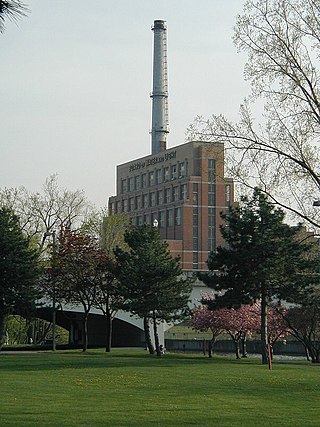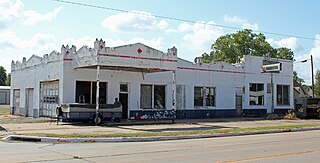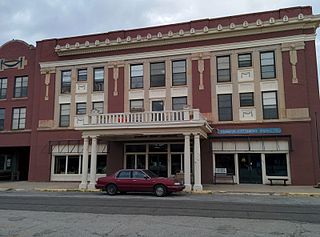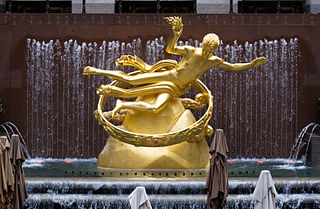
A motel, also known as a motor hotel, motor inn or motor lodge, is a hotel designed for motorists, usually having each room entered directly from the parking area for motor vehicles rather than through a central lobby. Entering dictionaries after World War II, the word motel, coined as a portmanteau of "motor hotel", originates from the defunct motel named Milestone Mo-Tel in San Luis Obispo, California, which was built in 1925. The term referred to a type of hotel consisting of a single building of connected rooms whose doors faced a parking lot and in some circumstances, a common area or a series of small cabins with common parking. Motels are often individually owned, though motel chains do exist.

The Hotel De Anza is a historic hotel in San Jose, California. At ten stories, it once was the tallest hotel in the San Jose central business district, prior to the construction of Hilton, Fairmont, and Marriott hotels. Significant for its architectural style, it is one of San Jose's few Zig Zag Moderne buildings. The hotel was listed on the National Register of Historic Places on January 21, 1982.

Ambler's Texaco Gas Station, also known as Becker's Marathon Gas Station, is a historic filling station located at the intersection of Old U.S. Route 66 and Illinois Route 17 in the village of Dwight, Illinois, United States. The station has been identified as the longest operating gas station along Route 66; it dispensed fuel for 66 continuous years until 1999. The station is a good example of a domestic style gas station and derives its most common names from ownership stints by two different men. North of the station is an extant outbuilding that once operated as a commercial icehouse. Ambler's was the subject of major restoration work from 2005 to 2007, and reopened as a Route 66 visitor's center in May 2007. It was added to the U.S. National Register of Historic Places in 2001.

The U-Drop Inn, also known as Tower Station and U-Drop Inn and Tower Café, was built in 1936 in Shamrock, Texas along the historic Route 66 highway in Wheeler County. Inspired by the image of a nail stuck in soil, the building was designed by J. C. Berry. An unusual example of art deco architecture applied to a gas station and restaurant, the building features two flared towers with geometric detailing, curvilinear massing, glazed ceramic tile walls, and neon light accents. It has traditionally held two separate business: "Tower Station," a gas station on the western side, and the "U-Drop Inn," a café on the eastern side. Though it has passed hands several times in its history, the building has consistently housed the same types of businesses it was originally constructed for.

Ottawa Street Power Station is a former municipal electric and steam utility generating station for the Lansing Board of Water and Light in Lansing, Michigan, located on the Grand River in the city's central business district that was redeveloped as corporate headquarters for the Accident Fund Insurance Company of America.

The Florence Hotel is a seven-story Moderne-style building in Downtown Missoula, Montana, which was completed in 1941. It was listed on the National Register of Historic Places in 1992.

The Young Brothers Chevrolet Garage is a site on the National Register of Historic Places located in Chinook, Montana. It has also been known as AAA Garage, as Taylor Motor Company, as Tilleman Chevrolet, and as Precision Auto Body. It was added to the Register on August 16, 1994. It is a stucco building with an asphalt roof.

The former Reno Main Post Office, located at 50 S. Virginia St. in Reno, Nevada, was built in 1933. The post office was designed by noted Nevada architect Frederic J. DeLongchamps and was built by the MacDonald Engineering Co., of Chicago, at cost of $363,660. This building was listed on the National Register of Historic Places in 1990. as U.S. Post Office-Reno Main.

The Endicott Hotel is a historic hotel building at 1-3 South Main Street in Concord, New Hampshire. Completed in 1894, it is the only known surviving work in the state of the regionally prominent Damon Brothers architects, and it was the first major commercial building on South Main Street. It was listed on the National Register of Historic Places in 1987.

The Sayre Champlin Service Station is a historic service station located on old U.S. Route 66 in Sayre, Oklahoma. The station, an affiliate of the Champlin Refining Company, was built in 1934; it replaced an older station which predated Route 66. Its main building has a Streamline Moderne design which features oval pilasters and horizontal sections, plate glass and multi-light windows, and a contrasting color scheme. The station provided both gasoline and automobile services to Route 66 travelers; in addition, the large tanker trucks used to supply the station's gasoline contributed to the highway's traffic. After Interstate 40 bypassed Route 66 in 1958, business at the station declined, and it closed permanently in 1967.

The Canute Service Station is a historic service station located along former U.S. Route 66 in Canute, Oklahoma. The service station was built in two sections; the western section opened in 1936 as a roadhouse, while the service station itself was added in 1939. The station was designed in the Pueblo Deco style, an architectural style which blended elements of the Art Deco and Pueblo Revival styles. The Pueblo Deco style was most popular in the Southwest, particularly among businesses on Route 66 looking to attract westbound travelers. The service station's Pueblo Deco elements include its stucco exterior, its castellated parapet decorated with tile diamonds, and its red tile roof.

The Jackson Conoco Service Station is a one-story brick structure located in El Reno, Oklahoma. Listed on the National Register of Historic Places in 2004, it was constructed by the Continental Oil Company in 1934 as a service station to serve the increasing automobile traffic along Route 66. Conoco built and operated many such facilities in the 1930s, all identical except for the positioning of the service bay; one other example is listed on the NRHP in Oklahoma, the Spraker Service Station in Vinita.

The Southern Hotel is a three-story Classical Revival structure located in El Reno, Oklahoma. Listed on the National Register of Historic Places in 1978, the building was constructed in 1909 as a hotel for passengers traveling the Rock Island Railroad as well as travelers along the Oklahoma Railway Company's interurban line to Oklahoma City. When it was built, the Southern Hotel was one of the most opulent and extravagant hotels in Oklahoma.

The Art Deco style, which originated in France just before World War I, had an important impact on architecture and design in the United States in the 1920s and 1930s. The most notable examples are the skyscrapers of New York City, including the Empire State Building, Chrysler Building, and Rockefeller Center. It combined modern aesthetics, fine craftsmanship, and expensive materials, and became the symbol of luxury and modernity. While rarely used in residences, it was frequently used for office buildings, government buildings, train stations, movie theaters, diners and department stores. It also was frequently used in furniture, and in the design of automobiles, ocean liners, and everyday objects such as toasters and radio sets.

The Best Oil and Refining Company Service Station is a historic building located in Cedar Rapids, Iowa, United States. This was the third service station built by business partners George D. Shaler and George J. Albright. Albright had previously been a building contractor and had owned a lumberyard, while Shaler was one of the founders of the Best Oil Company. The two were also in a partnership that acquired a limestone quarry in Stone City, Iowa, and that stone may have been used for the exterior of this building. This service station was located near a southeast side residential neighborhood, commercial and industrial areas from which it could attract customers. Built in 1930, the station sold gasoline and provided a wide range of automobile related maintenance needs until 1960 when it and other local service station operators gave way to the larger chain stores. While the station originally sold its own Best Oil brand gasoline, it eventually sold national brands such as Conoco. The building features a large canopy where the pumps were located, a metal cornice, and a service bay. After its use as a service station came to an end, the building has housed several non-automobile related businesses. It was listed on the National Register of Historic Places in 2014.

The Huning Highlands Conoco Service Station is a historic gas station in the Huning Highlands neighborhood of Albuquerque, New Mexico. It was built in 1937 by the Continental Oil Company (Conoco) and is notable as a well-preserved example of the automobile-oriented development that shaped the city during the mid-20th century. The building was listed on the New Mexico State Register of Cultural Properties and the National Register of Historic Places in 2006.
The Continental Oil Company Filling Station Building at 35 First Ave. N. in Kalispell, Montana is a historic filling station built around 1932 for the Continental Oil Company. It was listed on the National Register of Historic Places in 1994. Since October 2020 the building has been home to a Lemontree seasonal home decor store.
The Spraker Service Station, at 240 S. Wilson St. in Vinita, Oklahoma, United States, is a Tudor Revival-style Conoco filling station which was built in 1927. It was listed on the National Register of Historic Places in 1995.

















